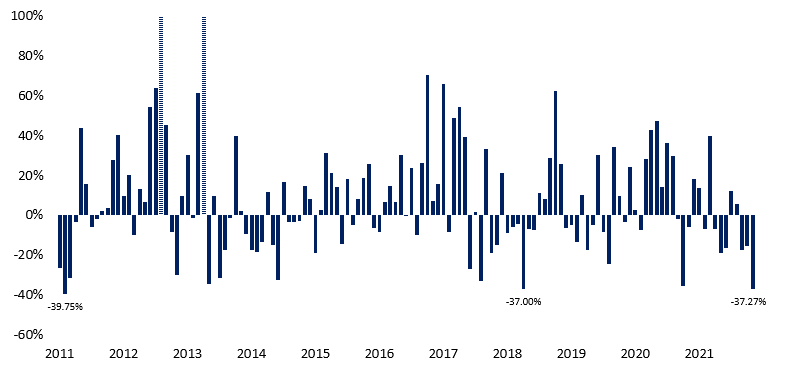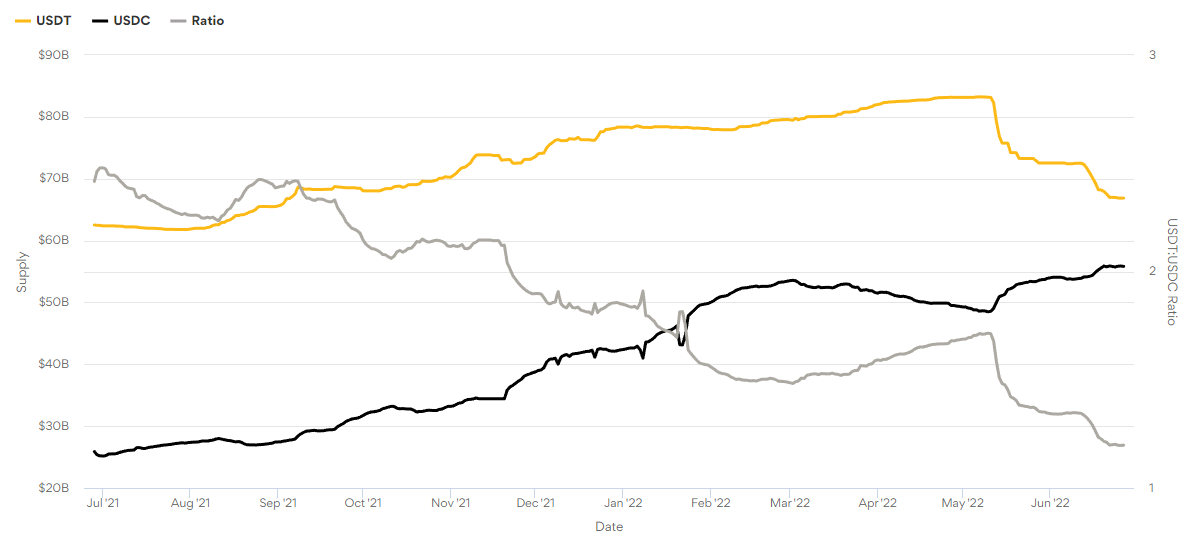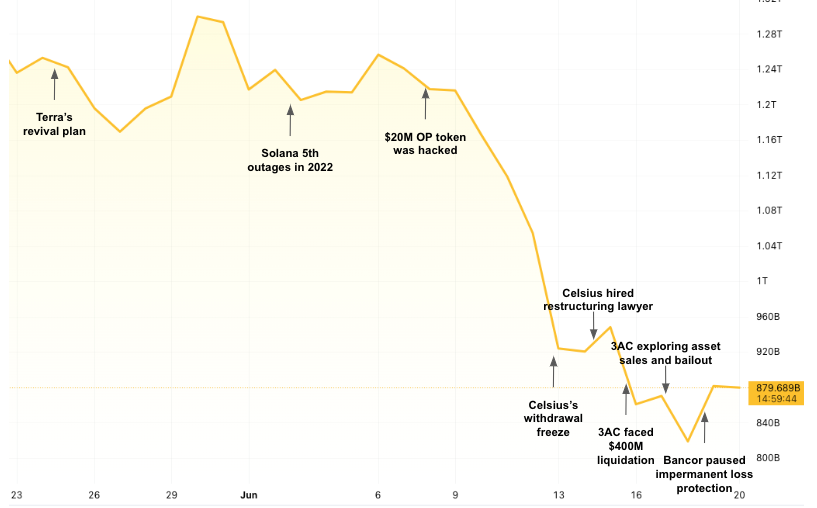A monthly review of what's happening in the crypto markets enriched with institutional research on the most important topics in the industry in cooperation with the Swiss digital asset specialist, 21Shares AG.
The overall crypto market capitalization is standing at $895B, down by 35% from $1.38T recorded by the end of May. Bitcoin’s (BTC) valuation shattered by almost 40% in June, its second-worst month ever, while Ethereum (ETH) is down by 48%. The best winners of June’s rally are Cardano and XRP, who dipped by 22% and 25% since last month. As the war intensifies between Russia and Ukraine, the grip tightens on resources, and purchasing power dwindles and goes hand-in-hand with the global food crisis into another era.
A pending recession may become a reality - affecting the public equity market. The S&P 500 and Eurostoxx 600 recorded their worst first half since 1970 and 2008 respectively. Regarding factors driving the market from within, there’s been a “contagious” liquidity crisis affecting various companies and funds in the aftermath of the Terra/Luna collapse, with bigger crypto companies like FTX stepping in as a buyer of last resort, and in some cases, walking away.

Rate hikes continue
On June 15, the Federal Reserve raised interest rates by 75 basis points; the biggest rate hike in 28 years. A day after, Biden signed the “Ocean Shipping Reform Act of 2022” to crack down on industry fees. While this measure aims to reduce inflation, at least marginally, it’s a big indicator that the supply chain crisis is just getting started.
Elon Musk, SpaceX, and Tesla are being sued for an alleged Ponzi scheme to loot $258B in Dogecoin. The plaintiff is a Dogecoin investor seeking a class-action lawsuit in the Southern District of New York against Musk and his companies for at least $86B in damages. The Securities and Exchanges Commission (SEC) is reportedly investigating how major crypto exchanges are working to prevent insider trading on exchanges.
Regulation and illicit activity
Binance has been facing some regulatory scrutiny as reports revealed that it has served as a conduit for the laundering of at least $2.35B in 5 years. However, its CEO, published a transparency report to refute these claims. The SEC is allegedly probing Binance’s native token BNB for potential violation of securities regulation. Texas, Alabama, and New Jersey are investigating Celsius Network’s decision to halt customer withdrawals, signalling the lending protocol’s insolvency. In a turn of tables, Grayscale is suing the SEC after rejecting its application to convert its flagship Grayscale Bitcoin Trust product to an ETF.
However, there are still some wins in this risk-off environment. Illicit crypto activities between 2021 and the first quarter of 2022 have dropped from 0.6% to 0.1%, according to data gathered by a blockchain forensics company powered by Mastercard. CipherTrace estimates that in 2020, illicit activity was between 0.62% and 0.65% of overall crypto activity, and it has now fallen to between 0.10% and 0.15% of overall activity in 2021. Other notable events were:
- Japan passed a bill limiting stablecoin issuers to licensed banks, registered money transfer agents and trust companies.
- Nigerian blockchain advocacy group, initiated by the president’s office, is introducing a code of conduct for VASPs with the purpose to make Nigeria the world’s safest and biggest blockchain space with the largest blockchain solutions, investments, and adoption.
- The EU Parliament and Council negotiators reached a provisional deal on a new bill aiming to ensure that crypto transfers can always be traced and suspicious transactions blocked. The rules however don’t apply to peer-to-peer transactions.
CeFi service providers crumble
The downfall of prices that took a sharp turn in May had a domino effect on crypto exchanges and DeFi platform, namely BlockFi, which lost almost 80% of its valuation. On June 21st, BlockFi’s CEO Zac Prince announced on Twitter that his company signed a term sheet with crypto exchange FTX to secure a $250M revolving credit facility to provide access to capital that further bolsters the crypto lender’s balance sheet and platform strength. The proceeds of the credit facility were intended to be contractually subordinate to all client balances across all account types (BIA, BPY and loan collateral) and will be used as needed. On June 30, news broke with the deal being sealed, on July 1st Prince announced that they amended the agreement to secure a $400M revolving credit facility which is subordinate to all client funds. The deal also comes FTX’s optional acquisition of BlockFi at a variable price of up to $240M based on performance triggers.
Celsius also took a hit, with allegedly a $2B hole in its balance sheets. Earlier in June, the lending protocol froze withdrawals and transfers, citing "extreme" market conditions, leaving its 1.7 million customers unable to redeem their assets. FTX was eyeing Celsius for acquisition but decided to walk away after examining its financial records.
Given the market downturn, investors are leaning more towards fully-collateralized and fiat-backed stablecoins, especially after the collapse of UST, Terra’s algorithmic stablecoin. Top-tier stablecoin issuers, Circle and Tether continue expanding their offerings to gain market share. For their existing dollar-pegged stablecoins, USDT will expand to Tezos and USDC will expand to Polygon. Tether will launch a new stablecoin GBPT, which is pegged to the British Pound Sterling. On the other hand, Circle also introduced a new Euro-backed stablecoin, EUROC to compete with Tether’s EURt. While Tether’s reserves have been the key concern for USDT critics, they have recently announced MHA will be auditing their reserves to increase transparency. Furthermore, they also announced they’ll decrease the amount of commercial paper for backing USDT from $20B to $8.4B by the end of June and eventually to zero.

Metaverse and NFTs
With Mckinsey and Company predicting that the metaverse could reach $5 trillion by 2030, June saw ceaseless adoption carried out by some of the biggest names in the fashion and entertainment industries. First was Prada’s latest initiative to launch a collection of NFTs freely available for those who purchase the Timecapsule apparel release. In a similar manner, Warner Bros company publicized their newest push to get into the NFT industry with the tokenization of the Looney Tunes story in the form of a 10K collection of the Tweety character. NFT holders should expect to enjoy an exclusive set of perks such as virtual meet and greet, special deals on physical collections and more.
There was also a controversy surrounding Bored Ape Yacht Club continued at the beginning of June as their discord server got hacked for the third time in 2 months leading to the loss of 200 ETH. Other developments in the metaverse and nft area:
- Swiss luxury watchmaker TAG Heuer introduced an NFT-enabled smartwatch.
- Lacoste will launch an NFT collection.
- Cristiano Ronaldo and Binance teamed up for an NFT partnership.
- Eminem and Snoop Dogg made a Bored Ape Yacht Club music video.
- Bentley Motors announced they’ll launch NFTs on Polygon.
Crypto Infrastructure
Solana waltzed into June with the fifth outage this year. This time, the network breakdown was triggered by the processing of offline transactions called durable transaction nonces; one of which was mistakenly processed like a normal one, instigating the user to resubmit it again and triggering the network’s double-spending issue as validators failed to reach consensus due to the runtime bug. As a result, developers have disabled the feature altogether to avert any future problems.

The developments within the infrastructure vertical didn’t stop there as the BNB network unveiled its latest technical roadmap, which should see improvements on multiple fronts. The upgrade includes fostering the capacity for launching sidechains to host NFT-based dApps, growing the total number of validators to 41 from 21, and increasing the block gas capacity to 200M to match the increased demand on the network.
The L1 BNB Beacon Chain announced it’s going open-source, allowing developers to build on it. The network will also open its validator set, inviting external parties to become validators and play an important role in governance. Users interested in contributing as delegators will also have an avenue to contribute through staking. As the BNB Beacon Chain is rolled out, different components will be reviewed to identify opportunities for more prospective validators and delegators to contribute and play an active role.
After a $400M liquidation by top-tier lenders on prop fund, Three Arrows Capital (3AC), it is speculated that 3AC is the next in line to be facing insolvency issues with failure to meet margin calls on BlockFi. With BlockFi and Deribit in its portfolio, 3AC has hired legal and financial advisers to help reclaim its position with lenders and other parties. However, a court in the British Virgin Islands ordered 3AC liquidation.
Expectations for the future
The SEC’s Gary Gensler is lobbying for one rule book on crypto exchanges that would essentially grant the SEC more jurisdiction over the industry. The mechanics of this rule book would be that if a token that represents a commodity is listed on a platform overseen by the SEC, they would notify the CFTC, which oversees commodities. On the regulatory front in the EU, after years of consultation and negatiation, institutions reached an agreement on the markets in crypto assets (MiCA) law expected to come into effect in late 2023. The law will represent the first unifed regulatory framework for cryptoassets in Europe with the mandate to protect consumers combat market manipulation and financial crimes. The silver lining is there won’t be any ban on Bitcoin mining but rather will require disclosure on energy consumption.
The realm of DeFi is being brutally battle tested. We can expect more companies following the steps of FTX, but most of all we expect surviving projects to set their sails for the next bear market. Having a roadmap, hiring and spending strategies that are tailored for risk-off environments would protect emerging companies against extreme market conditions and attract investors.
We’re starting to see more practical utility in NFTs beyond the hype of expensive JPEGs, like customer loyalty and retention. We might see new nonfungible trends getting propagated by the market conditions; like non fungible airdrops (NFA) for example, initiated by Arken Finance. Similar to futures contracts, NFAs would represent the true value of an airdrop reward when an initial DEX offering happens, however, the project owner would be the one promising to deliver the token or other digital assets on a future launch date.




